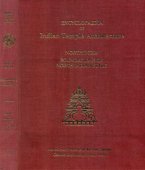Santara, Shantara, Samtara: 15 definitions
Introduction:
Santara means something in Hinduism, Sanskrit, Buddhism, Pali, Marathi, Jainism, Prakrit, Hindi, biology. If you want to know the exact meaning, history, etymology or English translation of this term then check out the descriptions on this page. Add your comment or reference to a book if you want to contribute to this summary article.
Biology (plants and animals)
Source: Wisdom Library: Local Names of Plants and DrugsSantara [संतरा] in the Hindi language is the name of a plant identified with Citrus reticulata Blanco from the Rutaceae (Lemon) family having the following synonyms: Citrus deliciosa, Citrus tangerina. For the possible medicinal usage of santara, you can check this page for potential sources and references, although be aware that any some or none of the side-effects may not be mentioned here, wether they be harmful or beneficial to health.
Santara [संतरा] in the Marathi language, ibid. previous identification.
Santara [سنترا] in the Urdu language, ibid. previous identification.
Source: Google Books: CRC World Dictionary (Regional names)Santara in India is the name of a plant defined with Citrus reticulata in various botanical sources. This page contains potential references in Ayurveda, modern medicine, and other folk traditions or local practices It has the synonym Citrus deliciosa Ten. (among others).
Example references for further research on medicinal uses or toxicity (see latin names for full list):
· Ciencia e Cultura (1984)
· Arnaldoa (2002)
· Species Plantarum (1753)
· Acta Genetica Sinica (1988)
· Flora Cochinchinensis (1790)
· Plantae Wilsonianae (1914)
If you are looking for specific details regarding Santara, for example chemical composition, pregnancy safety, side effects, health benefits, diet and recipes, extract dosage, have a look at these references.

This sections includes definitions from the five kingdoms of living things: Animals, Plants, Fungi, Protists and Monera. It will include both the official binomial nomenclature (scientific names usually in Latin) as well as regional spellings and variants.
Languages of India and abroad
Pali-English dictionary
Source: Sutta: The Pali Text Society's Pali-English DictionarySantara, (adj.) (sa3+antara, cp. E. with-in) inside; in compn °uttara inner & outer Vin. III, 214; IV, 281; °uttarena with an inner & outer garment Vin. I, 298; ThA. 171; °bāhira within & without D. I, 74; Dh. 315; J. I, 125; DA. I, 218; DhA. III, 488. (Page 676)

Pali is the language of the Tipiṭaka, which is the sacred canon of Theravāda Buddhism and contains much of the Buddha’s speech. Closeley related to Sanskrit, both languages are used interchangeably between religions.
Marathi-English dictionary
Source: DDSA: The Molesworth Marathi and English Dictionarysāntara (सांतर).—a (S sa & antara) Having interstices or intervals.
Source: DDSA: The Aryabhusan school dictionary, Marathi-Englishsāntara (सांतर).—a Having intervals.
Marathi is an Indo-European language having over 70 million native speakers people in (predominantly) Maharashtra India. Marathi, like many other Indo-Aryan languages, evolved from early forms of Prakrit, which itself is a subset of Sanskrit, one of the most ancient languages of the world.
Sanskrit dictionary
Source: DDSA: The practical Sanskrit-English dictionarySāntara (सान्तर).—a.
1) Having interstices or intervals.
2) Open in texture.
3) Not steadfast or firm; सान्तरं तु प्रतिज्ञाते राज्ञो द्रोणेन निग्रहे (sāntaraṃ tu pratijñāte rājño droṇena nigrahe) Mahābhārata (Bombay) 7.12.29.
Source: Cologne Digital Sanskrit Dictionaries: Edgerton Buddhist Hybrid Sanskrit DictionaryŚāntara (शान्तर).—[, corrupt, in defective verse Mahāvastu i.164.15; Senart, yathecchakaṃ (mss. yate°) araṇa-samādhi śāntara (read śānta ca ? compare Pali santaṃ samādhiṃ araṇaṃ, Critical Pali Dictionary s.v. araṇa)…(lacuna) devanareṣu (mss. devacareṣu) arcita, addressed to the Buddha.]
--- OR ---
Sāntara (सान्तर).—m., one of a list of kinds of monks who have no right to make valid objection to an action taken in the name of the saṃgha; perhaps schismatic, or having a weak point (? compare Critical Pali Dictionary s.v. ^2antara, A 2): Mūla-Sarvāstivāda-Vinaya ii.210.12 (context does not help).
Source: Cologne Digital Sanskrit Dictionaries: Shabda-Sagara Sanskrit-English DictionarySāntara (सान्तर).—mfn.
(-raḥ-rā-raṃ) 1. With intervals, or interstices. 2. Open in texture. E. sa for saha with, antara between.
Source: Cologne Digital Sanskrit Dictionaries: Benfey Sanskrit-English DictionarySāntara (सान्तर).—adj. with interstices.
Sāntara is a Sanskrit compound consisting of the terms sa and antara (अन्तर).
Source: Cologne Digital Sanskrit Dictionaries: Monier-Williams Sanskrit-English Dictionary1) Sāntara (सान्तर):—mf(ā)n. having an interval or interstices, [Mahābhārata]
2) different (opp. to eka-rūpa), [Varāha-mihira’s Bṛhat-saṃhitā]
3) having an intervening clause or appendix, [Mahābhārata]
4) not close or compact, open in texture, [cf. Lexicographers, esp. such as amarasiṃha, halāyudha, hemacandra, etc.]
5) mixed or mingled with others, [cf. Lexicographers, esp. such as amarasiṃha, halāyudha, hemacandra, etc.]
Source: Cologne Digital Sanskrit Dictionaries: Yates Sanskrit-English DictionarySāntara (सान्तर):—[(raḥ-rā-raṃ) a.] With intervals.
Source: DDSA: Paia-sadda-mahannavo; a comprehensive Prakrit Hindi dictionary (S)Saṃtāra (संतार) in the Sanskrit language is related to the Prakrit word: Saṃtāra.
[Sanskrit to German]
Sanskrit, also spelled संस्कृतम् (saṃskṛtam), is an ancient language of India commonly seen as the grandmother of the Indo-European language family (even English!). Closely allied with Prakrit and Pali, Sanskrit is more exhaustive in both grammar and terms and has the most extensive collection of literature in the world, greatly surpassing its sister-languages Greek and Latin.
Hindi dictionary
Source: DDSA: A practical Hindi-English dictionarySantara in Hindi refers in English to:—(nm) an orange..—santara (संतरा) is alternatively transliterated as Saṃtarā.
...
Prakrit-English dictionary
Source: DDSA: Paia-sadda-mahannavo; a comprehensive Prakrit Hindi dictionary1) Saṃtara (संतर) in the Prakrit language is related to the Sanskrit word: Saṃtṛ.
2) Saṃtāra (संतार) also relates to the Sanskrit word: Saṃtāra.
Prakrit is an ancient language closely associated with both Pali and Sanskrit. Jain literature is often composed in this language or sub-dialects, such as the Agamas and their commentaries which are written in Ardhamagadhi and Maharashtri Prakrit. The earliest extant texts can be dated to as early as the 4th century BCE although core portions might be older.
See also (Relevant definitions)
Partial matches: Sha, Antara, Ca.
Starts with: Santarabahira, Santarabahiram, Santarala, Santaram, Santaramana, Santaran, Santarana, Santarapluta, Santarasparsha, Santarati, Santarayata, Shantaraja, Shantarajas, Shantarakshita, Shantarasa, Shantarasanataka, Shantarashmi, Shantarava, Shantaraya.
Ends with (+9): Abhisantara, Amshantara, Asprishtapurushantara, Avakashantara, Bhasantara, Cakshushantara, Chakshushantara, Dashantara, Deshabhashantara, Deshantara, Divasantara, Dosantara, Grasantara, Kakshantara, Lakshantara, Nasamtara, Nimeshantara, Nimishantara, Ovasamtara, Pakshantara.
Full-text: Samtara, Parnasantara, Santarapluta, Abhisantara, Samtri, Nadisamtara, Santarottara, Samtaranau, Santarbahi, Dhritimaya, Bahira, Ucchada, Pota, Mantha, Antara, Cint.
Relevant text
Search found 10 books and stories containing Santara, Sa-antara, Samtara, Saṃtara, Saṃtāra, Sāntara, Śāntara, Santāra, Shantara; (plurals include: Santaras, antaras, Samtaras, Saṃtaras, Saṃtāras, Sāntaras, Śāntaras, Santāras, Shantaras). You can also click to the full overview containing English textual excerpts. Below are direct links for the most relevant articles:
Kavyamimamsa of Rajasekhara (Study) (by Debabrata Barai)
Part 3.11 - Nature of Vākya (sentence) and their types < [Chapter 5 - Analyasis and Interpretations of the Kāvyamīmāṃsā]
The Tattvasangraha [with commentary] (by Ganganatha Jha)
Verse 658 < [Chapter 11 - On ‘Quality’ as a Category]
The Buddhist Philosophy of Universal Flux (by Satkari Mookerjee)
Chapter XVIII - Prāpyakāritvavāda or Relation of the Sense-organ with the Object < [Part II - Logic and Epistemology]
The Brahmanda Purana (by G.V. Tagare)
Chapter 62 - The science of music < [Section 3 - Upodghāta-pāda]
The “Rukminiparinaya” < [April – June, 1987]
Formal Education System in Ancient India (by Sushmita Nath)
Education in the Epic Period < [Chapter 1 - Introduction]
Related products

